Libraries and museums have a nearly limitless capacity for
improving the lives of the people they serve. They advance
our education, enhance our ability to achieve economic prosperity,
broaden our understanding of our own heritage and of cultures
around the world, improve the condition of our neighborhoods,
and provide us with opportunities for civic engagement and
the knowledge to make that engagement meaningful.
Each year, to recognize exemplary public service, IMLS solicits
nominations of museums and libraries that exceed expectations
and demonstrate outstanding service to their communities.
Members of the National Museum and Library Services Board,
the advisory board for IMLS, study these nominations looking
for the most innovative, energetic, and effective programs.
They then recommend their top choices to the IMLS Director,
who makes final selections for the National Awards for Museum
and Library Service, the nation’s highest honor for
these institutions.
For 2006, IMLS is recognizing three museums and three public
libraries that are as diverse as the museum and library fields
themselves. The museum awardees include a world-class aquarium
in a major city, a children’s zoo in America’s
heartland, and an art museum that travels on rails to remote
communities across the country. The award-winning libraries
include one serving a Texas city of more than a million people
with a large Spanish-speaking population, another in a Midwestern
county with fewer than 40,000 residents and a desire for cultural
enrichment, and a third that boasts the largest service area
of any library system in the Carolinas. All of these outstanding
institutions have become indispensable to the communities
they serve.
Artrain USA
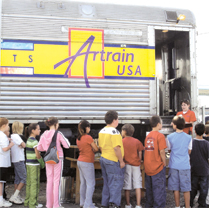 When
Artrain USA chugs into town, communities are changed. Housed
in vintage train cars and pulled by locomotives, the traveling
museum brings world-class art exhibitions to communities across
the country that may have little or no access to art museums. When
Artrain USA chugs into town, communities are changed. Housed
in vintage train cars and pulled by locomotives, the traveling
museum brings world-class art exhibitions to communities across
the country that may have little or no access to art museums.
Artrain USA is a nonprofit organization that educates people
about art and exposes them to the ways it can enrich lives.
Its audience includes individuals of all ages, circumstances,
and educational backgrounds who lack access to the arts and
who do not travel to large museums or seek out cultural experiences.
Typically a third of the 100 communities Artrain USA visits
annually are small towns of fewer than 10,000 people. In these
communities Artrain USA usually reaches roughly half the population.
Prior to an Artrain USA visit, the museum provides a variety
of tools and assistance to the host organization to ensure
that the exhibition will be a community-wide success. The
preparation experience itself has important benefits that
last long after the train has left town. In planning that
can take as many as 18 months and involve as many as 100 volunteers,
the hosting organization learns to organize a steering committee,
fundraise, coordinate volunteers, and collaborate with diverse
community organizations. Artrain USA works with the host organization
every step of the way, providing valuable guidance to individuals
who often have no formal arts or nonprofit training.
With each new national tour, Artrain USA leaves in its tracks
special art encounters for underserved individuals and new
know-how for small town arts organizations to continue thinking
big.
Frankfort
Community Public Library
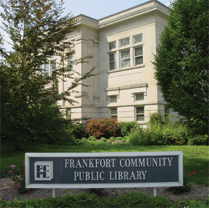 The
town of Frankfort is 45 miles from Indianapolis in a county
that supports agriculture and a large manufacturing industrial
park. The county wanted more, however, in the way of arts
and culture. The Frankfort Community Public Library has been
filling that void since 1988, when ground was broken for a
new wing with a theater, music room, and art gallery. The
library expanded its offerings when it added the Anna and
Harlan Hubbard School of Living, which provides a steady stream
of classes for adults and children and fosters the idea, “We
can make our life a work of art.” The
town of Frankfort is 45 miles from Indianapolis in a county
that supports agriculture and a large manufacturing industrial
park. The county wanted more, however, in the way of arts
and culture. The Frankfort Community Public Library has been
filling that void since 1988, when ground was broken for a
new wing with a theater, music room, and art gallery. The
library expanded its offerings when it added the Anna and
Harlan Hubbard School of Living, which provides a steady stream
of classes for adults and children and fosters the idea, “We
can make our life a work of art.”
The library has the only public art space in town. Its art
display reaches an audience that includes residents who may
not have the opportunity to visit a museum or gallery, as
well as patrons who may have come for story hour or to check
out a book. The Hubbard School provides free art classes for
children, allowing them to interact with professional artists
and teachers and to create works that might also be displayed.
The school also provides the community with free live music
events, including a free monthly presentation of local musicians
in the library’s coffee shop and a concert series in
the library theater.
Two years ago the library joined the city, the local newspaper,
Hispanic Community Services, and other groups to present a
Hispanic Cultural Arts Festival. It also hosts a bi-annual
Japanese Festival in cooperation with the town’s Japanese-owned
businesses.
The Frankfort Community Public Library has become the source
of enrichment experiences that would simply not be available
otherwise.
John G.
Shedd Aquarium
 The
John G. Shedd Aquarium wants residents of Chicago to know
more about the immense and beautiful body of water in their
backyard. The Great Lakes supply 37 million residents with
water, but the lakes’ ecosystem is vulnerable. Spreading
conservation awareness messages is one way the 75-year-old
Shedd Aquarium is fulfilling its mission to show that marine
life connects people to the living world and inspires people
to make a difference. The
John G. Shedd Aquarium wants residents of Chicago to know
more about the immense and beautiful body of water in their
backyard. The Great Lakes supply 37 million residents with
water, but the lakes’ ecosystem is vulnerable. Spreading
conservation awareness messages is one way the 75-year-old
Shedd Aquarium is fulfilling its mission to show that marine
life connects people to the living world and inspires people
to make a difference.
The Shedd launched its Great Lakes Initiative in 2005 and
has since participated in advertising, promotional, and evaluative
activities to ensure the messages are reaching Great Lakes
basin residents. The aquarium also integrates the messages
of this campaign into education, outreach programs, special
events, and exhibits. Its Invasive Species exhibit brings
the public face-to-face with such non-native species as the
zebra mussel or the Asian carp. The exhibit describes the
harm caused by these non-native species and explains what
people can do to prevent introducing or spreading invasive
species. The Right Bite program is another conservation awareness
effort involving multiple partners. The program aims to inform
the public that there is a connection between their seafood
purchases and the health of the world’s oceans and that
by buying the right fish, consumers can help protect the ocean
habitats.
The Shedd also fulfills its mission through education programs,
such as its Floor Programs and its South Chicago Initiative.
Floor Programs help create a dynamic connection between aquarium
visitors and the collections with friendly staff members who
engage visitors in a variety of activities.
The John G. Shedd Aquarium’s conservation awareness
campaigns and its multi-faceted educational programs reflect
its strong leadership in the field and ensure its place as
one of the most popular destinations in Chicago.
Lincoln
Children’s Zoo
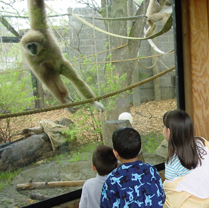 Lincoln
Children’s Zoo is a natural oasis in the heart of downtown
Lincoln, Nebraska. The institution has seen great changes
in the city and its demographics during its 40-year existence
and has responded with a range of programs that make the natural
world accessible to even the most underserved groups. Lincoln
Children’s Zoo is a natural oasis in the heart of downtown
Lincoln, Nebraska. The institution has seen great changes
in the city and its demographics during its 40-year existence
and has responded with a range of programs that make the natural
world accessible to even the most underserved groups.
The 19 acres of animal exhibits and gardens are within walking
distance of three elementary inner-city schools and the city’s
largest public high school. The Children’s Zoo also
supports the Lincoln Public School’s Science Focus High
School, which is located on zoo grounds. This proximity to
schools naturally led to educational partnerships for the
zoo, including Bug Bash, Animals in the Classroom, and Through
the Seasons, all of which strive to teach life science concepts
in ways that appeal to young people.
In response to an influx of immigrants into the city, the
Lincoln Children’s Zoo has augmented its successful
educational outreach to extend a hand to newcomers and other
groups who might otherwise be excluded. Its efforts led to
the development of a network of cultural community centers,
ethnic grocery stores, churches, and social service agencies;
awareness training for staff and board members; and annual
community workshops bringing together more than 60 community
organizations to explore ways to meet the needs of a culturally
diverse audience.
The Lincoln Children’s Zoo has grown and evolved along
with its community, and today it sets a high standard for
other Lincoln cultural and educational institutions by making
the most of the city’s rich diversity.
Public Library
of Charlotte and Mecklenburg County
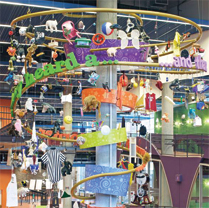 The
Public Library of Charlotte and Mecklenburg County seeks to
expand minds, empower individuals, and enrich its community.
As the largest public library system in the Carolinas, the
library has plenty of individuals to serve. The
Public Library of Charlotte and Mecklenburg County seeks to
expand minds, empower individuals, and enrich its community.
As the largest public library system in the Carolinas, the
library has plenty of individuals to serve.
The library’s projects include emergent literacy initiatives,
such as Storytimes to Go!, which reaches more than 6,500 children
annually with pre-reading and school readiness activities
and themed kits; and Connections that Count/Conexiones que
Cuenton to prepare Hispanic preschool children for school
success through weekly story time sessions in apartments and
centers in Hispanic neighborhoods.
Teens are drawn to the library’s summer reading program,
Train Your Brain, because it is all online. They participate
via the program Web site, where they can learn about the prizes
and the library’s on-site teen programs, and reserve
books online. The Novello Festival of Reading, begun 15 years
ago, is an annual community-wide book read for residents of
all ages.
More than 3,500 students visited PLCMC’s ThinkCOLLEGE®
for counseling and preparation resources last year, and library
staff at many other branches worked together to offer financial
aid workshops, SAT preparation, and career fairs. In 2005,
the library initiated Enterprising Teens, a young entrepreneurs
program at its Freedom Regional Library located in a predominantly
African American community.
The Public Library of Charlotte and Mecklenburg County has
been most innovative with its facility partnerships. These
joint-use facilities have been developed with transportation
providers, schools, law enforcement, and retailers, among
others.
The Public Library of Charlotte and Mecklenburg County exemplifies
an approach to service and programming that can transform
lives.
San Antonio
Public Library
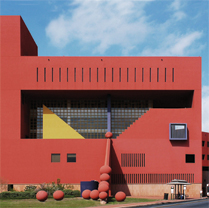 The
San Antonio Public Library is working to make its city of
1.2 million people a community of learning. It serves this
largely Hispanic population by providing the building blocks
of literacy. Each of its many programs and services, no matter
the audience targeted, includes a component for the underserved
Spanish-speaking population. It is a strategy that addresses
the cultural mosaic of the San Antonio community and is helping
to boost library usage. The
San Antonio Public Library is working to make its city of
1.2 million people a community of learning. It serves this
largely Hispanic population by providing the building blocks
of literacy. Each of its many programs and services, no matter
the audience targeted, includes a component for the underserved
Spanish-speaking population. It is a strategy that addresses
the cultural mosaic of the San Antonio community and is helping
to boost library usage.
The strength of the library’s commitment to literacy
is demonstrated in its large-scale Born to Read program. Designed
to develop a generation of readers, the program currently
reaches each of the 25,000 babies born annually in San Antonio.
Through partnerships with hospitals and pediatric offices,
the new mothers receive literacy kits filled with bi-cultural
books, a library card application, a map showing the library
branch locations, and coupons redeemable for a CD of lullabies
and books from an area bookstore.
A partnership with childcare organizations, preschools, community
centers, and detention centers has resulted in Little Read
Wagon, an emergent literacy program that encourages parents
and childcare workers to read to children and provides them
with the skills to inspire children to love reading.
The library offers many learning opportunities for the general
population and works to make art and art education accessible
to all both within and beyond the library walls.
From the youngest of residents to the area’s seniors,
the San Antonio Public Library is known as a place for literacy
and lifelong learning.
|